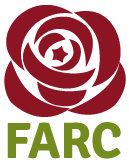Common Alternative Revolutionary Force
The Common Alternative Revolutionary Force[3] (Spanish: Fuerza Alternativa Revolucionaria del Común) is a communist political party in Colombia, established in 2017 as the political successor of the former rebel group the Revolutionary Armed Forces of Colombia (FARC). The peace accords agreed upon by the Revolutionary Armed Forces of Colombia and the Colombian government in 2016 provided for the FARC's participation in politics as a legal, registered political party following its successful disarmament.
Common Alternative Revolutionary Force Fuerza Alternativa Revolucionaria del Común | |
|---|---|
 | |
| Abbreviation | FARC |
| President | Timoleón Jiménez |
| Founded | September 1, 2017 |
| Legalised | October 31, 2017 |
| Preceded by | FARC CCCP |
| Women's and LGBT wing | Farianas y Diversidad |
| Ideology | Communism Marxism–Leninism[1] Bolivarianism |
| Political position | Left-wing to far-left |
| International affiliation | IMCWP[2] |
| Colors | Red Green White |
| Chamber of Representatives | 5 / 172 |
| Senate | 5 / 108 |
| Governors | 0 / 32 |
| Mayors | 0 / 1,102 |
| Website | |
| Partido FARC | |
The party was founded after a failed referendum in October 2016 with the majority of Colombian voters voting to reject the peace agreement.[4] The "yes" campaign to accept the peace negotiations were pushed by President Santos, while the "no" campaign to reject the agreement was backed by former president Álvaro Uribe. The "no" vote won with 50.2% of the vote. The failed referendum came after four years of peace negotiations. After mild alterations to the peace agreements, the government approved the new deal by pushing it through Congress.[5] This has led to some controversy with those who voted no arguing that the deal offered too much leniency.[6]
Founding Congress
The party's founding congress was held in the Bogota Convention Centre from August 28 to August 31, 2017 with the participation of one thousand delegates, including former FARC militants and members of the Colombian Clandestine Communist Party,[7] as well as some 200 invitees from various sectors of Colombian society and delegations from left-wing groups in other countries, primarily those in Latin America and the Caribbean.[8] The congress concluded on September 1 with the unveiling of the new party in Bogotá's Plaza Bolívar, with over ten thousand people in attendance. In his speech, party leader Timoleón Jiménez put forth a proposal for a national transition government for the 2018–2022 term.[9]
The National Directorate is made up of 111 members. In total, 26 women were elected, representing 23% of the new party's leadership.[10]
The party's name, chosen to maintain the acronym FARC used by its armed predecessor, was agreed upon on August 31, 2017 during the party's founding congress, prevailing over the other proposed name, Nueva Colombia ("New Colombia") by 628 votes. The party's logo, a design with a rose and a red star in the center, was revealed at the same time.[11]
Goals
FARC will have 10 automatic seats in Congress through 2026 per the deal reached via the accord.[12] They will continue to attempt to fight poverty and corruption, specifically in rural areas, focusing on land reform.[13] They are looking to form a coalition with other communist groups to gain additional seats in Congress 2018, as they remain ideologically Marxist.
Election results
| Election year | # of overall votes |
% of overall vote |
# of overall seats won |
+/– | Government |
|---|---|---|---|---|---|
| 2018 | 32,636 #21 | 0.38% | 5 | +5 |
See also
- Clandestine Colombian Communist Party
- Patriotic March
- Patriotic Union
References
- "Atención! Estos son los estatutos de la Fuerza Alternativa Revolucionaria del Común". Archived from the original on 2017-11-07. Retrieved 2017-11-09.
- IMCWP. "Communist and Workers' Parties". IMCWP. Retrieved 16 February 2019.CS1 maint: uses authors parameter (link)
- "Colombia's FARC Unveils New Political Party". CNN. 31 August 2017. Retrieved 4 September 2017.
- "Colombia referendum: Voters reject Farc peace deal". BBC News. 3 October 2016. Retrieved 29 November 2017.
- "Colombia's Congress Approves Peace Accord With FARC". New York Times. 30 November 2016. Retrieved 29 November 2017.
- "In U.S., Colombians React to Historic 'No' on Peace Accord". NBC News. 3 October 2016. Retrieved 29 November 2017.
- "Así llegarán las Farc al Congreso". El Espectador (in Spanish). 28 August 2017. Retrieved 3 September 2017.
- "Fuerza Alternativa Revolucionaria del Común" (in Spanish). 2 September 2017. Retrieved 2 September 2017.
- "El día en que las Farc se tomaron la plaza de Bolivar" (in Spanish). Las2orillas. 2 September 2017. Retrieved 3 September 2017.
- "111 miembros conforman dirección nacional de las Farc". Vanguardia.com. 2 September 2017.
- "Con nuevo logo y nombre las Farc entran en la política" (in Spanish). Caracol Radio. 1 September 2017. Retrieved 2 September 2017.
- "Colombia clears path for former FARC members to hold office". CNN. 28 April 2017. Retrieved 29 November 2017.
- "Colombia's FARC political party looks to coalition for 2018 elections". Reuters. 1 September 2017. Retrieved 29 November 2017.